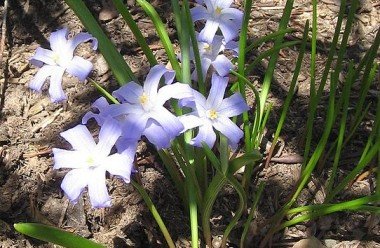
This slow, cool spring is frustrating for gardeners, but good for perennial plants. Their roots are growing in the soil, weeks ahead of first shoots appearing above ground. New root growth enlarges their clumps, and they’ll be better prepared for summer droughts that may be ahead. The cool dampness also prolongs the bulb display, giving us a long look at the spring garden. This has provided me with an opportunity to survey my garden’s small, minor bulbs to see which are still going strong and note where some have been disappearing.
The crocus are almost finished, with only a few bright yellow stragglers still blooming. Several years ago, I planted 400 crocus (both species and named cultivars) throughout the garden, but I certainly didn’t see that many blooms this spring. Time to renew them and purchase a few dozen for autumn planting.
About the same time, I planted several dozen each of blue Siberian squill (Scilla sibirica), blue and white glory-of-the-snow (Chionodoxa luciliae), and bluish-white striped squill (Puschkinia libanotica). These have noticeably spread, reproducing from bulblets, and make lovely carpets in empty corners and under shrubs. The Siberian squills are popping up in the lawn, which suggests they may have spread by seed, although I can’t find any authoritative reference to this method. But certainly something good is happening. These species bulbs were a good investment and possibly won’t ever need to be renewed.
I also have just a dozen each of hybrid bulbs — Scilla siberica ‘Spring Beauty’ and Chionodoxa luciliae ‘Pink Giant’. They show the results of plant breeding and are larger than their species cousins. These hybrids return reliably every year, but they don’t spread and probably don’t make any bulblets. They’re quite showy and I think a few more clumps of each would be worth having, so will put them on the purchase list.
The question in my mind is—why did the crocus bulbs decline, while the other minor bulbs increased? Possibly because of where I planted them. The crocus are sharing the bed with perennial plants, and this area is irrigated in summer. Perhaps the moist soil works against the crocus bulbs’ preference for wet spring and dry summer conditions. Probably many of the crocus have succumbed to rot and the bulbs have died. The other minor bulb species are growing in drier locations, in corners and under the skirts of shrubs, where soil is moist in spring, but summer irrigation isn’t so frequent. The dry summer conditions favour better bulb health and bulblet reproduction by discouraging fungus rot infections. If I’m going to plant future purchases of minor bulbs into moist perennial beds, I’ll have to expect shorter lifespan from them.
Reactivating peat moss
I enjoy opening a fresh bale of peat moss and catching the moist, peaty, forest-like scent it delivers. But sometimes what I find is a dusty, dried-out block of peat that a trowel can’t penetrate. When peat moss bales are stored in warm, dry warehouses, their moisture evaporates and the peat fibres harden. This can also happen to a bale in your garage that isn’t kept tightly closed between uses. Dry, hardened peat fibres shed cold water. That means they won’t adequately rehydrate with soil moisture in a planting hole, and they’ll also shed the cold water from your watering can.
Salvaging dried-out peat is easy. Hot water reactivates peat moss, softening the fibres and filling them with moisture again. It’s not enough to just pour hot water (carried from the kitchen sink) into the dry bale. The dry peat needs to be broken up and dumped into a wheelbarrow (or for a large amount, use a rigid plastic kiddy pool), the hot water poured over, and then worked through with a garden fork, trowel or hand claw tool to spread the moisture through the fibres. You’ll be surprised how much hot water it takes to adequately reactivate the peat.
Peat is a sphagnum moss that grows in wet bog lands, and much of what is used for horticultural purposes in North America is harvested in Canada. Peat moss is a useful product for gardening purposes because it holds both moisture and oxygen, and helps to soften soil texture. Peat moss doesn’t have any nutritional value, but it is acidic and benefits alkaline soil. There is growing concern about the ecological damage caused to indigenous plant and animal species when peat bogs are mined, a process that effectively kills the ecosystem on the site. Because of environmental considerations, I use peat moss sparingly, and rely more on leaves (either whole or shredded), shredded bark and conifer needles. My only outdoor use for peat this year is as a thin covering for grass seeds while they germinate. Indoors, I use a small amount for starting annual and perennial seeds. This spring, I purchased some blocks of coir (a natural fibre extracted from coconut husks), and I’ll be incorporating this material into container soil. Things change, and we find better ways to garden without causing damage to bogs and their fragile plant and animal companions.
Thanks for visiting with me at Making a Garden. I’ll be looking for you next week!








